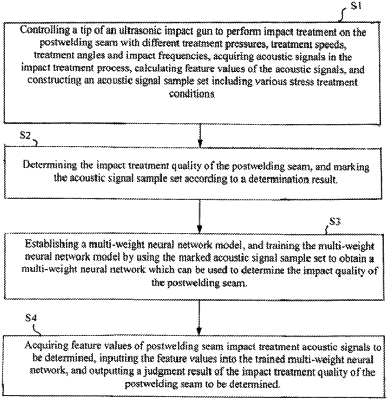| CPC G01N 29/045 (2013.01) [B23K 37/00 (2013.01); G01N 29/46 (2013.01); G01N 33/207 (2019.01); G06N 3/08 (2013.01); H04R 3/04 (2013.01); B23K 31/006 (2013.01); B23K 31/125 (2013.01); G01N 29/348 (2013.01); G01N 29/4481 (2013.01); G01N 2291/0234 (2013.01); G01N 2291/0289 (2013.01); G01N 2291/267 (2013.01); G01N 2291/2675 (2013.01); G06T 7/11 (2017.01); G06T 2207/20084 (2013.01); H04R 1/08 (2013.01)] | 3 Claims |

|
1. A method for determining a smart acoustic information recognition-based welded weld impact quality, comprising the following steps:
S1) controlling a tip of an ultrasonic impact gun to perform impact treatment on a postwelding seam with different treatment pressures, treatment speeds, treatment angles and impact frequencies, acquiring acoustic signals in the impact treatment process, calculating feature values of the acoustic signals, and constructing an acoustic signal sample set including various stress treatment conditions;
S2) determining an impact treatment quality of the postwelding seam, and marking the acoustic signal sample set according to a determination result;
in a determination process, a resistance strain-gage is used as a sensitive element for measurement, and an indentation is made at a center of a strain rosette by impact loading; the strain-gage records the change of strain increment in an elastic area outside an indentation area, obtaining a true elastic strain corresponding to a residual stress and further calculating a stress;
a stress relief ratio is calculated by a formula: stress relief ratio=(stress of postwelding seam after impact treatment/stress of postwelding seam before impact treatment)*100%, where the stress of the postwelding seam before impact treatment is a stress of the whole weldment; if the stress relief ratio is higher than 70%, the impact quality is marked as qualified; and if the stress relief ratio is lower than 70%, the impact quality is marked as unqualified;
S3) establishing a multi-weight neural network model, and training the multi-weight neural network model by using the marked acoustic signal sample set marked in S2) to obtain a multi-weight neural network which is used to determine the impact quality of the postwelding seam;
step 1: taking four features of each acoustic signal acquired by a training sample acquisition module as a feature vector sample point, labeling them as A1, A2, . . . , AN, calculating a distance between any two points in a feature sample set, and storing the distance in an N×N matrix A, where Aij represents a distance between acoustic signal feature sample points Ai and Aj, and Aii=0 (i=1, 2, . . . , N);
step 2: finding a minimum value in the N×N matrix A, labeling the serial numbers (subscript characters) of two closest acoustic signal feature sample points to be found as P11 and P12, and constructing a first neuron θ1 by the two corresponding acoustic signal feature sample points;
step 3: deleting a point covered by the first neuron θ1 from the acoustic signal feature sample point set {A1, A2, . . . , AN}, calculating a distance from each remaining point to the points P11 and P12, finding out two points with the shortest distance, labeling them as P21 and P22, and constructing a second neuron θ2 of MDOFNN with the acoustic signal feature sample points P21 and P22;
step 4: repeating step 3 on the remaining acoustic signal feature sample points to obtain Pi1Pi2, and constructing an ith neuron θi; and
step 5: obtaining N−1 connected neuron line models when i=N−1, meaning that all the points in the acoustic signal feature sample set have been processed;
wherein two multi-weight neuron coverage areas representing “qualified treatment quality” and “unqualified treatment quality” are obtained finally through algorithm iteration, and an Euclidean distance between a test sample and the two multi-weight neuron network coverage areas representing a stress treatment quality of the postwelding seam is calculated; the ones with closer Euclidean distance to the “qualified treatment quality” multi-weight neuron coverage area are the ones with qualified stress treatment quality of the postwelding seam in the test sample, and the ones with closer Euclidean distance to the “unqualified treatment quality” multi-weight neuron coverage area are the ones with unqualified stress treatment quality of the postwelding seam in the test sample;
S4) acquiring feature values of postwelding seam impact treatment acoustic signals to be determined, inputting the feature values into the multi-weight neural network trained in S3), and outputting a judgment result of the impact treatment quality of the postwelding seam to be determined, wherein judging whether the impact treatment of the postwelding seam is “qualified treatment quality”.
|